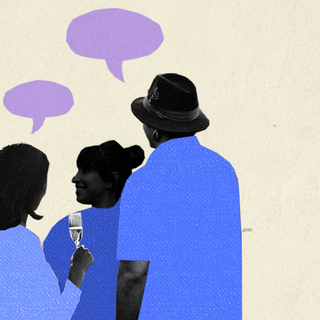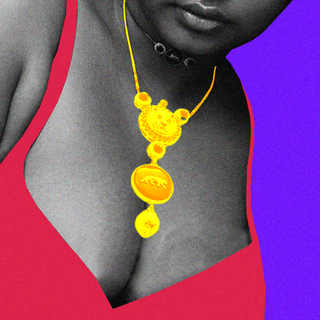
What Happens When You Take the Male Gaze Out of Mythologies
In feminist retellings of ‘The Mahabharata’ and ‘The Odyssey,’ female characters can be flawed and powerful.

In Amruta Patil’s Adi Parva, a graphic novel retelling of The Mahabharata, the river goddess Ganga is the sutradhar (narrator). She wears a white saree that billows in every direction, with hair almost running to her knees, speckled with stardust and (to my unfortunate eyes) dandruff. I am very reassured by this Ganga. Like a lot of millennials, having grown up with Amar Chitra Katha comics depicting mythologies, I never envisioned a wild and free, doe-eyed, wise Ganga. Comic retellings of Indian epics involved a Ganga in colorful clothes carefully draped around her torso, no cleavage, hair tucked in proper with hair gel, not a speck out of place in the goddess’ ensemble. Amruta Patil’s Ganga doesn’t wear jewelry. That tracks. If I were a powerful, unbridled river worshipped by decades of pollution, I wouldn’t wear any shiny objects either.
From C Rajagopalachari to Ramanand Sagar, men have dominated imaginations of how we hear mythologies of war, wisdom, and moral woes. For the dudebros who will rush to the defense of oxidized-earringed Lord Krishna in Ramanand Sagar epics, here take this acknowledgment first: the time when Sagar’s epics aired in the 90s on Doordarshan was when the Indian middle-class ate fictional propriety for breakfast. These mythological retellings spoke to joint family fears, encouraging gender roles.
Hindi TV shows and movies ever since decided they will remind women in Indian families what a wonderful job Sita in Ramayana did by walking through fire to prove her “purity” from a 10-headed dude who like, you know, kidnapped her and stuff. It took a woman to question this whole prove-your-piety business. Remember, Madhuri Dixit in the film adaption of Taslima Nasreen’s Lajja? Dixit’s character refused to enact the agnee-pareeksha (trial by fire) made famous by all the men who wrote Ramayana (and adapted into pop culture by..some more men).
Dixit’s Sita said, “Excuse me, but why?” Which was probably the first logical question a woman in a mythological story dominated by men has ever asked. Because, to the world of men writing, reading, reciting, and re-enacting these epics, asking a woman to walk through fire for — once again — getting kidnapped, was just a regular Tuesday.
So it was not until women started translating or interpreting these tales that the real life lessons they promised stood out to me. Take, for example, the epic poem The Odyssey, largely credited to the Greek writer Homer, although contested by many historians whether he birthed the story himself or simply turned it into an anthology via many other Homers. The Odyssey is about Odysseus, the king of Ithaca, returning home from a long journey through perils and quests. Among the plethora of Greek stories, The Odyssey has, debatably, been the most celebrated. The intense epic weaves many murderous adventures, love stories that put Shakespeares in several dimensions to shame, monstrous creatures, super “casual” sexual assaults, slavery, and the whole shebang. To this day, it is touted as a philosophy guide in many academic circles. Nobody’s denying the potential life lessons hidden under its numerous apostrophes. There’s a life lesson everywhere if you look long enough. It’s why the abyss is my spiritual guru.
But the epic falls short in getting through to 2021 in many ways. There’s only so long that you can contextualize something to “its time” as an excuse. It’s why feminist retellings are important. Because mythologies are malleable to the passing of time and the demands of each era, its life lessons need updates. For a younger generation of readers, the overtly moralistic, gender normative, sexualized retellings of mythologies don’t (rightfully) stick. But mythologies also contain cyclical, timeless life lessons that are useful to understanding human behavior and social structures (all the casteism in The Mahabharata, anyone?).
So when Emily Wilson translated The Odyssey — the first woman to do so — it opened a universe to several readers who were either exhausted by the male gaze in complex plotlines or just wanted perspectives that apply to their lives. In Wilson’s translation, Penelope, the queen of Ithaca, gets a much wider room for analysis. In Wilson’s own words, “The Iliad has very few major female characters. The Odyssey, however, devotes significant time to the life (and even the dreams) of Penelope. Circe, Calypso, and the goddess Athena all play important roles. This was one of the reasons I was drawn to The Odyssey as a teenager, and why I’ve returned to it many times over the years.”
Related on The Swaddle:
Author Chitra Banerjee Divakaruni on the Value of Epics in the #MeToo Era
When you read epics through the eyes of Wilson and Patil, you return to moments of vulnerability and linger there. For example, Adi Parva deliberately underlines the political role of Kunti, the mother of the Pandavas in The Mahabharata. As a single mother, she willfully navigated the fate of the kingdom. If I had stayed with C Rajagopalachari, whose iteration first introduced me to the epic, I’d have stayed with a version of Kunti defined by her widowhood, constantly regretful of her actions. I would have never learned of her strength, her political acumen, and her defiance without Adi Parva and other feminist retellings.
Similarly, Wilson’s translation of The Odyssey in simple, readable language helps young readers stay with Penelope, and along with her, a woman’s right to be opaque and hard-to-read. Wilson does not make it easy for the reader to like Penelope, but she also doesn’t take her gaze away from the queen. For the first time in the history of the epic poem, you sit with the relief and discomfort of being a “difficult” woman.
Sometimes in literature, when you take the male gaze out of the room, the real meditations begin. Patil continues to iterate on the concept of a sutradhar, literally translated to someone who holds the string [of a story] together. Adi Parva’s Ganga, when she’s done telling her story, passes the thread to another, not bothering to quench her audience’s piqued curiosities; trailing behind another life lesson I never learned from reading men: you don’t owe anyone your stories.
Shruti Sunderraman is the Associate Managing Editor at The Swaddle. She can be found on Twitter at @sundermanbegins.
Related


The Buzz Cut: Luxury Fashion House’s ‘Sexy’ Mangalsutras Accidentally Give Left And Right Common Thing To Hate
